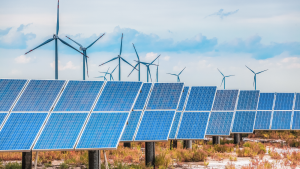In fact, last year the amount of renewable energy capacity added globally jumped 50% compared to 2022. And well-respected consulting firm Wood Mackenzie is predicting that, outside of China, a huge annual average of 85 gigawatts of wind energy will be added globally in the next decade. In the last decade, the ten-year average was just 37 gigawatts.
In February, Reuters reported that “A growing thirst for data storage is driving up U.S. power demand and creating new opportunities for solar and wind developers.” Indeed, data center operators usually want to buy “reliable, low carbon power supply at competitive costs.” So it’s no wonder that many tech companies are buying a great deal of power generated by solar and wind.
For investors who want to exploit these strong trends, here are three renewable energy stocks to buy now.
GE Vernova (GEV)

GE Vernova (NYSE:GEV), which manufactures wind turbines, is well-positioned to benefit from the growing demand for wind power. The company will also get a big boost from the world’s need to build new power plants and update electrical grids as renewables are utilized to a greater extent and as electrical demand increases. Consequently, GE Vernova is one of the best renewable energy stocks to buy now.
Morgan Stanley agrees with my thesis. In May, the investment bank wrote that the firm’s “(electrical) equipment and service offerings” would enable it to benefit from the increasing demand for electricity, the need for greater power grid reliability and worldwide efforts to reduce carbon emissions.
GE Vernova’s renewables segment, dominated by its wind turbine business, is slated to break even this year after losing $1.44 billion in 2023 and $2.24 billion in 2023, respectively. Analysts forecast the renewables division to be profitable in 2025.
The company’s grid electrification business, which offers transformers, switch gears and other electrical equipment, should get a big boost as electric demand increases. The latter phenomenon is occurring due to the electrification of transportation and the proliferation of huge data centers.
Enphase Energy (ENPH)

Two major Wall Street banks — Barclays and Goldman Sachs — have issued very upbeat notes on Enphase Energy (NASDAQ:ENPH) stock since April. Solar panels use Enphase’s microinverters.
In April, Barclays hiked its rating on the stock to “overweight” from “equal weight.” The bank expects the demand for Enphase’s inverters to rise and it was upbeat on the stock’s valuation. Barclays raised its price target on the shares to $134 from $115.
Goldman Sachs placed ENPH stock on its U.S. “conviction list” in June. The bank expects the company’s revenue to rise as a result of the depletion of the inventories of its products in California. Additionally, Goldman predicts that the company’s financial results will increase from heightened demand for its home batteries.
In another indication that the Street is becoming more bullish on the shares, Enphase’s stock rose nearly 25% between July 2 and July 12.
First Solar (FSLR)

In May, Swiss bank UBS identified First Solar (NASDAQ:FSLR) stock as a play on the proliferation of artificial intelligence.
Specifically, UBS expects First Solar to benefit from large tech companies’ increased consumption of electricity in the AI era. They are pledging to offset any fossil fuels they use with equivalent purchases of renewable energy. UBS also predicts that First Solar’s market share in the U.S. will continue to climb going forward.
The U.S. Energy Information Administration predicts utilization of solar power in the U.S. will expand 75% between 2023 and 2025. First Solar’s top line will likely boom if its share of the rapidly growing sector expands.
Indeed, analysts predict the firm’s revenue will jump 36% this year before climbing another 25% in 2025. Their average estimate calls for First Solar’s earnings per share to jump to $13.59 and $21.38 in 2024 and 2025, respectively, versus just $7.74 in 2023.
First Solar’s strong growth and upbeat outlook make it one of the best renewable energy stocks to buy now.
On the date of publication, Larry Ramer held a long position in GEV. The opinions expressed in this article are those of the writer, subject to the InvestorPlace.com Publishing Guidelines.
On the date of publication, the responsible editor did not have (either directly or indirectly) any positions in the securities mentioned in this article.
Larry Ramer has conducted research and written articles on U.S. stocks for 15 years. He has been employed by The Fly and Israel’s largest business newspaper, Globes. Larry began writing columns for InvestorPlace in 2015. Among his highly successful, contrarian picks have been SMCI, INTC, and MGM. You can reach him on Stocktwits at @larryramer.
